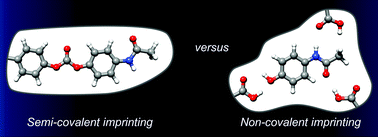Synthesis and ligand recognition of paracetamol selective polymers: semi-covalent versus non-covalent molecular imprinting†
Abstract
Three molecular imprinting strategies, each based upon a series of

* Corresponding authors
a
Bioorganic and Biophysical Chemistry Laboratory, School of Pure and Applied Natural Sciences, University of Kalmar, Sweden
E-mail:
ian.nicholls@hik.se
Fax: +46 480 446244
Tel: +46 480 446258
Three molecular imprinting strategies, each based upon a series of

 Please wait while we load your content...
Something went wrong. Try again?
Please wait while we load your content...
Something went wrong. Try again?
J. P. Rosengren-Holmberg, J. G. Karlsson, J. Svenson, H. S. Andersson and I. A. Nicholls, Org. Biomol. Chem., 2009, 7, 3148 DOI: 10.1039/B900014C
To request permission to reproduce material from this article, please go to the Copyright Clearance Center request page.
If you are an author contributing to an RSC publication, you do not need to request permission provided correct acknowledgement is given.
If you are the author of this article, you do not need to request permission to reproduce figures and diagrams provided correct acknowledgement is given. If you want to reproduce the whole article in a third-party publication (excluding your thesis/dissertation for which permission is not required) please go to the Copyright Clearance Center request page.
Read more about how to correctly acknowledge RSC content.
 Fetching data from CrossRef.
Fetching data from CrossRef.
This may take some time to load.
Loading related content
